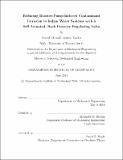| dc.contributor.advisor | Alexander H. Slocum. | en_US |
| dc.contributor.author | Taylor, David Donald James | en_US |
| dc.contributor.other | Massachusetts Institute of Technology. Department of Mechanical Engineering. | en_US |
| dc.coverage.spatial | a-ii--- | en_US |
| dc.date.accessioned | 2014-12-08T18:09:16Z | |
| dc.date.available | 2014-12-08T18:09:16Z | |
| dc.date.copyright | 2014 | en_US |
| dc.date.issued | 2014 | en_US |
| dc.identifier.uri | http://hdl.handle.net/1721.1/92062 | |
| dc.description | Thesis: S.M., Massachusetts Institute of Technology, Department of Mechanical Engineering, 2014. | en_US |
| dc.description | This electronic version was submitted by the student author. The certified thesis is available in the Institute Archives and Special Collections. | en_US |
| dc.description | Cataloged from PDF version of thesis. | en_US |
| dc.description | Includes bibliographical references (pages 151-155). | en_US |
| dc.description.abstract | Intermittently-operated water systems struggle to equitably and effectively distribute clean water to customers. One common customer response to intermittency is to supplement the water system's pressure by using a household, or residential, booster pump. When such booster pumps are directly connected to the water utility's supply pipe, without an underground isolation tank (sump), they often induce negative pressure in the supply pipe which increases the flow rate. Unfortunately, where leakage rates are high, this negative pressure also increases the risk of contaminant intrusion. This thesis presents the iterative design and field testing of a patent-pending, full-bore, back-pressure regulating valve. The valve's simple mechanism relies on a stabilized collapsing tube, or 'Starling Resistor,'which when installed at a customer's connection, controls the flow rate and prevents booster pumps from creating negative pressure in the supply pipe. In collaboration with the Delhi Jal Board and several private partners, the valve's performance was verified in two rounds of field trials in neighborhoods of New Delhi, India including Pitampura, Azad Market, Vivek Vihar, Malvia Nagar, and Vasant Vihar. Using a crossover study, the valve was found to reduce the total contamination risk across all 19 tested houses during supply times by a median of 80%. The valve prevented 96% of pressure below -1 meter and an average of 53 minutes per day, per connection of total negative pressure. In an estimated worst-case scenario for contaminant intrusion, the presence of the valve reduced the contamination risk by two orders of magnitude at six customer connections - enough to correspond to significant reductions in health risks. | en_US |
| dc.description.statementofresponsibility | by David Donald James Taylor. | en_US |
| dc.format.extent | 192 pages | en_US |
| dc.language.iso | eng | en_US |
| dc.publisher | Massachusetts Institute of Technology | en_US |
| dc.rights | M.I.T. theses are protected by copyright. They may be viewed from this source for any purpose, but reproduction or distribution in any format is prohibited without written permission. See provided URL for inquiries about permission. | en_US |
| dc.rights.uri | http://dspace.mit.edu/handle/1721.1/7582 | en_US |
| dc.subject | Mechanical Engineering. | en_US |
| dc.title | Reducing booster-pump-induced contaminant intrusion in Indian water systems with a self-actuated, back-pressure regulating valve | en_US |
| dc.type | Thesis | en_US |
| dc.description.degree | S.M. | en_US |
| dc.contributor.department | Massachusetts Institute of Technology. Department of Mechanical Engineering | |
| dc.identifier.oclc | 896109093 | en_US |
